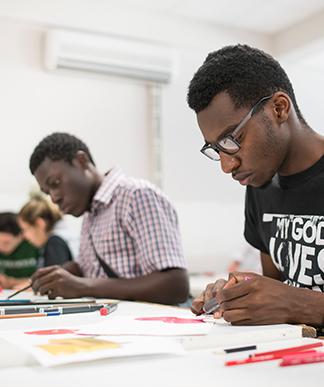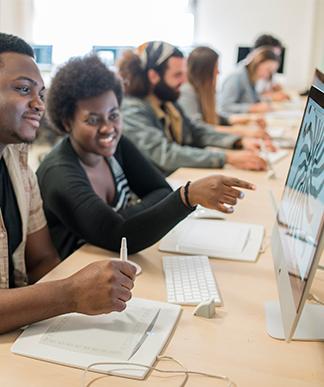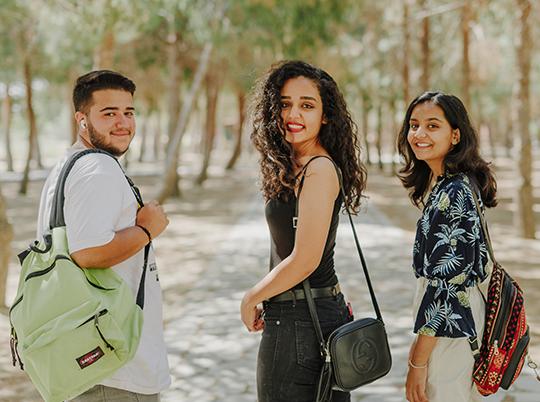


About the Department
Graphic design education is at the intersection of communication, art, and design. Graphic design improves the aesthetic qualities with its artistic approach, and the need to establish proper communication as well. Our students first gain the ability to see and perceive through this artistic point of view. Then, throughout their education, they learn various methods and techniques in order to bring words, symbols, and images together to represent the visual expressions of thoughts and ideas, and form new formats. The department trains designers who are in harmony with the dynamic nature of our age. They are also aesthetically and technically equipped with the ability to produce creative thinking and be confident and prepared for the contemporary requirements in areas such as product logos, envelopes, business cards, files, packaging designs, box designs, posters, interior designs, open air adverts, flyers, catalogs, corporate identities, brand positioning, web design, photos, print pictures and illustrations.
Education Opportunities
The curriculum is refreshed and modified according to the changes and developments in the current design sector. In the project courses, multidirectional preparation and multidisciplinary studies are provided for the design process of the students. There is also a jury system that contributes to the development of students through which the students express themselves and present their work to the members of the department and guest jury members. Throughout their education, students of Graphic Design have plenty of opportunities to attend various design events which are arranged by the department such as design talks, workshops, seminars, and exhibitions. Students are also encouraged to study the local design and visual communication issues with an international-based design awareness.
Academic activities are held in studios, classrooms, field-specific laboratories, workshops, and even the technical trips where courses are conducted. In addition to PC Laboratories where graphic design programs can be used, there is a Macintosh Laboratory and digital drawing pads for the use of students of the Graphic Design Department. Students can use the design programs in this laboratory and make digital drawings and illustrations. In addition, they can apply woodcut, linocut, and intaglio printing methods in the Graphic Printing Workshop and do detailed studies in the field of printing.
In the Graphic Design program, students have the opportunity to study a second bachelor's degree (double major) or a certain field (minor) as a student in a different program.

Career Areas
The Department of Graphic Design aims to educate professionals with the skills of designing, implementing, sharing and managing, with a learner and learning focus as well as visual, cultural and aesthetic point of view; are based on benefit-value creation and questioning; are sensitive, creative, social, cultural and environmentally-sensitive and responsible. There is a large preference scale for the designers who graduate from our department. Businesses working online or that exist in any market sector require the services of graphic designers. Individuals graduating from the Department of Graphic Design can work in the design departments of advertising agencies, magazines and newspapers, design firms, and in the design teams of corporate firms. In addition, our graduates can work in the field of contemporary media taking on responsibility in different fields of art.
Contact
Faculty of Fine Arts, Design and Architecture
Education and Humanities Center, EH323
Tel: +90 392 671 1111 Extension: 2101
Faculty E-mail: secretary-ffa@ciu.edu.tr
Acting Head of Department: Prof. Dr. Cemil ATAKARA
Head of Department E-mail: catakara@ciu.edu.tr
Compulsory Courses
First Semester
READING AND WRITING SKILLS-I
Course code
ENGL141Credit
3Theoretical
2Practical
2Ects
4FREEHAND DRAWING
Course code
FADA103Credit
2Theoretical
2Practical
1Ects
4BASIC DESIGN-I
Course code
GRDE101Credit
6Theoretical
4Practical
4Ects
10GRAPHICAL COMMUNICATION-I
Course code
GRDE105Credit
3Theoretical
2Practical
2Ects
6INTRODUCTION TO COMPUTERS
Course code
ITEC110Credit
3Theoretical
3Practical
0Ects
4Second Semester
READING AND WRITING SKILLS-II
Course code
ENGL142Credit
3Theoretical
2Practical
2Ects
4BASIC DESIGN-II
Course code
GRDE102Credit
6Theoretical
4Practical
4Ects
10GRAPHICAL COMMUNICATION-II
Course code
GRDE106Credit
3Theoretical
2Practical
2Ects
6DIGITAL PRACTICE
Course code
GRDE108Credit
3Theoretical
2Practical
2Ects
5SKETCHING IN DESIGN
Course code
GRDE110Credit
3Theoretical
2Practical
2Ects
5TURKISH LANGUAGE
Course code
TREG100Credit
0Theoretical
2Practical
0Ects
2TURKISH
Course code
TURK100Credit
0Theoretical
2Practical
0Ects
2Third Semester
FREE ELECTIVE
Course code
FREEXX1Credit
3Theoretical
3Practical
0Ects
6FREE ELECTIVE
Course code
FREEXX2Credit
2Theoretical
2Practical
0Ects
4GRAPHIC DESIGN-I
Course code
GRDE201Credit
6Theoretical
4Practical
4Ects
10COMPUTER AIDEDGRAPHIC DESIGN-I
Course code
GRDE203Credit
3Theoretical
2Practical
2Ects
4TYPOGRAPHY-I
Course code
GRDE205Credit
3Theoretical
2Practical
2Ects
5Fourth Semester
FREE ELECTIVE
Course code
FREEXX3Credit
3Theoretical
3Practical
0Ects
6FREE ELECTIVE
Course code
FREEXX4Credit
2Theoretical
2Practical
0Ects
5GRAPHIC DESIGN-II
Course code
GRDE202Credit
6Theoretical
4Practical
4Ects
10TYPOGRAPHY-II
Course code
GRDE206Credit
3Theoretical
2Practical
2Ects
5ADVANCED PHOTOGRAPHY
Course code
GRDE208Credit
3Theoretical
2Practical
2Ects
5Fifth Semester
SUMMER TRAINING-I
Course code
GRDE200Credit
0Theoretical
0Practical
0Ects
3GRAPHIC DESIGN-III
Course code
GRDE301Credit
6Theoretical
4Practical
4Ects
10INTERACTIVE DESIGN
Course code
GRDE303Credit
3Theoretical
2Practical
2Ects
4ADVERTISING DESIGN
Course code
GRDE307Credit
3Theoretical
2Practical
2Ects
4AREA ELECTIVE
Course code
GRDEXX1Credit
2Theoretical
2Practical
0Ects
4AREA ELECTIVE
Course code
GRDEXX2Credit
2Theoretical
2Practical
0Ects
4Sixth Semester
GRAPHIC DESIGN-IV
Course code
GRDE302Credit
6Theoretical
4Practical
4Ects
10COLOUR CULTURE
Course code
GRDE304Credit
3Theoretical
2Practical
2Ects
4VIDEOART AND MULTIMEDIA
Course code
GRDE306Credit
3Theoretical
2Practical
2Ects
5PACKAGE DESIGN
Course code
GRDE310Credit
3Theoretical
2Practical
2Ects
4AREA ELECTIVE
Course code
GRDEXX3Credit
2Theoretical
2Practical
0Ects
4AREA ELECTIVE
Course code
GRDEXX4Credit
2Theoretical
2Practical
0Ects
4Seventh Semester
SUMMER TRAINING-II
Course code
GRDE300Credit
0Theoretical
0Practical
0Ects
3GRAPHIC DESIGN-V
Course code
GRDE401Credit
6Theoretical
4Practical
4Ects
10CONCEPTUAL ILLUSTRATION
Course code
GRDE403Credit
3Theoretical
2Practical
2Ects
4GRADUATION PROJECT RESEARCH IN GRAPHIC DESIGN
Course code
GRDE405Credit
3Theoretical
3Practical
0Ects
4AREA ELECTIVE
Course code
GRDEXX5Credit
3Theoretical
3Practical
0Ects
4UNIVERSITY ELECTIVE
Course code
UNIEXX1Credit
3Theoretical
3Practical
0Ects
5Eighth Semester
GRAPHIC DESIGN GRADUATION PROJECT
Course code
GRDE402Credit
6Theoretical
4Practical
4Ects
10PORTFOLIO DESIGN
Course code
GRDE404Credit
3Theoretical
2Practical
2Ects
4AREA ELECTIVE
Course code
GRDEXX6Credit
3Theoretical
3Practical
0Ects
4HISTORY OF CIVILIZATION
Course code
HIST100Credit
0Theoretical
2Practical
0Ects
2MODERN TURKISH HISTORY
Course code
TARH100Credit
0Theoretical
2Practical
0Ects
2UNIVERSITY ELECTIVE
Course code
UNIEXX2Credit
3Theoretical
3Practical
0Ects
5UNIVERSITY ELECTIVE
Course code
UNIEXX3Credit
3Theoretical
3Practical
0Ects
5Elective Courses
CREATIVITY IN DESIGN
Course code
GRAP461Credit
2Theoretical
2Practical
0Ects
DESIGN FOR SUSTAINABILITY
Course code
INPD309Credit
3Theoretical
2Practical
2Ects
4HISTORY OF INTERIORS AND FURNITURE
Course code
INAR308Credit
2Theoretical
2Practical
0Ects
4ERGONOMICS IN INTERIOR DESIGN
Course code
INAR107Credit
3Theoretical
2Practical
2Ects
5EXHIBITION DESIGN
Course code
GRAP465Credit
2Theoretical
2Practical
0Ects
3BASIC PHOTOGRAPHY
Course code
GRDE207Credit
3Theoretical
2Practical
2Ects
5WORKSHOP PRACTICE IN MODEL MAKING
Course code
INPD207Credit
3Theoretical
2Practical
2Ects
6HISTORY OF ART-I
Course code
FADA209Credit
2Theoretical
2Practical
0Ects
2PRINTMAKING TECHNIQUES
Course code
GRDE305Credit
3Theoretical
2Practical
2Ects
5SOCIAL & IDEO. ISSUES OF SPACE
Course code
ARCH414Credit
2Theoretical
2Practical
0Ects
3HISTORY OF ARTS-II
Course code
FADA210Credit
2Theoretical
2Practical
0Ects
2COMPUTER AIDED GRAPHIC DESIGN-II
Course code
GRDE204Credit
3Theoretical
2Practical
2Ects
5HISTORY OF GRAPHIC DESIGN
Course code
GRDE311Credit
2Theoretical
2Practical
0Ects
2VISUAL DESIGN WITH COMPUTER AIDED PRESENTATION
Course code
ARCH421Credit
3Theoretical
3Practical
0Ects
3WOOD AND GLASS TECHNOLOGY
Course code
ARCH409Credit
2Theoretical
2Practical
0Ects
CONTEMPORARY GRAPHIC DESIGN
Course code
GRDE312Credit
2Theoretical
2Practical
0Ects
2SPACE ANALYSIS TECHNIQUES
Course code
ARCH477Credit
2Theoretical
2Practical
0Ects
MEDITERRANEAN ARCHITECTURE
Course code
ARCH420Credit
2Theoretical
2Practical
0Ects
3MARKETING AND CONSUMER BEHAVIOUR
Course code
FADA309Credit
3Theoretical
3Practical
0Ects
3ARCHITECTURAL SPACE IN MOVIES
Course code
ARCH241Credit
2Theoretical
2Practical
0Ects
MARINE BREAKWATER TYPES AND CHARACTERISTICS
Course code
ARCH485Credit
3Theoretical
3Practical
0Ects
3CLAY AND PLASTER IN DESIGN
Course code
INPD456Credit
2Theoretical
2Practical
0Ects
VIRTUAL REALITY IN ARCHITECTURE
Course code
ARCH470Credit
2Theoretical
2Practical
0Ects
3TRNC citizens and TR citizen candidate students who have completed their entire high school education in TRNC. They are placed in undergraduate programs in line with their success in the CIU Student Placement and Scholarship Ranking Exam and the programs they prefer.
Students who are successful in the exam can register from the TRNC Marketing Office.
Applicants can directly apply online to our undergraduate programs by using the application portal. Please fill in your details correctly and upload all the required documents listed on the last page of the application form.
Required documents;
- Completed application form,
- Higher/Secondary Certificate or equivalents (e.g. O/A’Level, WAEC/NECO)
- Evidence of English Language competence: TOEFL (65 IBT) or IELTS (5.5). Students without these documents will take the CIU English proficiency exam on campus following arrival,
- Scanned copy of international passport/birth certificate,
- Fully completed and signed CIU Rules and Regulations document (which can be downloaded during the online application).
Cyprus International University provides academic scholarships for its students as an incentive for success, with most students benefiting from 50%, 75% or 100% scholarships or discounted tuition fees. Click for more information.
Tuition Fees are determined at the beginning of each academic year. Candidate students who are entitled to enroll in CIU can learn their fees in line with the Tuition Fee Calculation system.